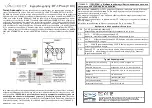
DynaJet® IC7140
www.teejet.com
22
1
2
3
4
5
6
7
8
9
A
Test 2 – Duty Cycle 50%
1.
Start by setting DynaJet IC7140 duty cycle to
50%
.
Test 2A – Minimum Operating Pressure
Determine controller gains/values with operating pressure at
MINIMUM.
2.
Reduce target rate or machine speed until system reaches
the minimum operating pressure.
3.
Adjust the rate controller gain value until stable.
Controller gain value at minimum pressure:
Test 2B – Maximum Operating Pressure
Determine controller gains/values with operating pressure at
MAXIMUM.
4.
Increase target rate or machine speed until system reaches
the maximum operating pressure.
5.
Adjust the rate controller gain value until stable.
Controller gain value at maximum pressure:
Test 3 – Duty Cycle “Minimum Duty Cycle”
1.
Start by setting DynaJet IC7140 duty cycle set to “Minimum Duty
Cycle” value (default is
30%
)
Test 3A – Minimum Operating Pressure
Determine controller gains/values with operating pressure at
MINIMUM.
2.
Reduce target rate or machine speed until system reaches
the minimum operating pressure.
3.
Adjust the rate controller gain value until stable.
Controller gain value at minimum pressure:
Test 3B – Maximum Operating Pressure
Determine controller gains/values with operating pressure at
MAXIMUM.
4.
Increase target rate or machine speed until system reaches
the maximum operating pressure.
5.
Adjust the rate controller gain value until stable.
Controller gain value at maximum pressure:
NO. 6 CALIBRATE THE DYNAJET IC7140 SYSTEM
The following steps will use Proportional Gain and Derivative Gain to
tune the DynaJet System. Proportional Gain will be increased until the
system is oscillating across the target pressure then stepped down to
stability. Once that is occurring then Derivative Gain will be increased
to bring the pressure to target quickly, yet not so high as to introduce
oscillation.
•
The lower the target droplet size, the higher the Derivative Gain
can be set; therefore, tuning needs to be done at highest
pressure/smallest droplet size that the machine will typically be
operating.
•
Speed changes, target droplet size changes or droplet size
engagement/disablement will be required for the best tuning
possible.
•
Target droplet size changes are preferred, but driving the
machine is ok.
•
Steady speeds are required.
Proportional Gain
Used to settle smaller errors by getting to the target droplet size more
quickly and with less noise in the system.
◄
Gain Too Low – getting close to the target droplet size will
be slow (unable to maintain within 10% of the target droplet
size). While the system is trying to reach a target droplet
size, the actual pressure will slowly get closer to the target to
avoid passing the target before reaching a steady-state.
◄
Gain Too High – getting close to the target droplet size will
be noisy or oscillate around the target droplet size. While the
system is trying to settle on a target droplet size, the actual
pressure may pass the target several times before reaching
a steady-state.
Figure 3-7:
Proportional Gain
Red diamond illustrates stability or noise trying to reach the green
target diamond.
Derivative Gain
Used to settle larger errors by getting to the approximate target
droplet size more quickly. For example, if a boom section is turned on,
derivative gain then applies a one-time gain. Because the action of the
boom on was quick and the rate of change was short, derivative gain
is then stronger.
◄
Gain Too Low – getting close to the target droplet size will
be slow. While the system is trying to reach a target droplet
size, the actual pressure will slowly get closer to the target to
avoid passing the target before reaching a steady-state. This
often occurs when there is a large pressure change on the
system such as a droplet size engagement/disablement or
dramatic speed change.
Gain Too Low
Gain Good
Gain Too High
Содержание DYNAJET IC7 140
Страница 1: ...DYNAJET IC7140 INSTALLATION SETUP USER MANUAL 98 05347 R1...
Страница 73: ......
















































